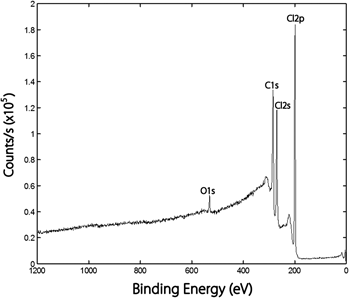Crossref Citations
This article has been cited by the following publications. This list is generated based on data provided by
Crossref.
Wang, Lili
Guo, Cong
Zhu, Yongchun
Zhou, Jianbin
Fan, Long
and
Qian, Yitai
2014.
A FeCl2-graphite sandwich composite with Cl doping in graphite layers: a new anode material for high-performance Li-ion batteries.
Nanoscale,
Vol. 6,
Issue. 23,
p.
14174.
Abdelkader, Victor K.
Domingo-García, María
Melguizo, Manuel
López-Garzón, Rafael
Javier López-Garzón, F.
and
Pérez-Mendoza, Manuel
2015.
Covalent bromination of multi-walled carbon nanotubes by iodine bromide and cold plasma treatments.
Carbon,
Vol. 93,
Issue. ,
p.
276.
Zhang, Xu
Schiros, Theanne
Nordlund, Dennis
Shin, Yong Cheol
Kong, Jing
Dresselhaus, Mildred
and
Palacios, Tomás
2015.
X‐Ray Spectroscopic Investigation of Chlorinated Graphene: Surface Structure and Electronic Effects.
Advanced Functional Materials,
Vol. 25,
Issue. 26,
p.
4163.
Lai, Shuangquan
Jin, Yong
Sun, Xiaopeng
Pan, Jiezhou
Du, Weining
and
Shi, Liangjie
2018.
Aqueous-based bromination of graphene by electrophilic substitution reaction: a defect-free approach for graphene functionalization.
Research on Chemical Intermediates,
Vol. 44,
Issue. 5,
p.
3523.
Bulusheva, L.G.
Sysoev, V.I.
Lobiak, E.V.
Fedoseeva, Yu.V.
Makarova, A.A.
Dubois, M.
Flahaut, E.
and
Okotrub, A.V.
2019.
Chlorinated holey double-walled carbon nanotubes for relative humidity sensors.
Carbon,
Vol. 148,
Issue. ,
p.
413.
Gifford, Brendan J.
2019.
Computational Photocatalysis: Modeling of Photophysics and Photochemistry at Interfaces.
Vol. 1331,
Issue. ,
p.
181.
Diyuk, V. E.
Zaderko, A. N.
Grishchenko, L. M.
Vakaliuk, A. V.
Mariychuk, R.
and
Lisnyak, V. V.
2021.
Nanooptics and Photonics, Nanochemistry and Nanobiotechnology, and Their Applications.
Vol. 264,
Issue. ,
p.
171.
Zhang, Jiayan
Wang, Ping
Wen, Hao
Raza, Saleem
Zhu, Ziyi
Huang, Wei
Liang, Lizhu
and
Liu, Changkun
2021.
Polymer brush-grafted cotton with petal-like microstructure as superhydrophobic and self-cleaning adsorbents for oil/water separation.
Colloids and Surfaces A: Physicochemical and Engineering Aspects,
Vol. 621,
Issue. ,
p.
126548.
Diyuk, V. E.
Grishchenko, L. M.
Vakaliuk, A. V.
Tsapyuk, G. G.
Mischanchuk, O. V.
Boldyrieva, O. Yu.
Mariychuk, R.
and
Lisnyak, V. V.
2023.
Nanomaterials and Nanocomposites, Nanostructure Surfaces, and Their Applications.
Vol. 279,
Issue. ,
p.
439.
Weight, Braden M.
Gifford, Brendan J.
Tiffany, Grace
Henderson, Elva
Mihaylov, Deyan
Kilin, Dmitri
and
Kilina, Svetlana
2024.
Optically active defects in carbon nanotubes via chlorination: computational insights.
RSC Applied Interfaces,
Vol. 1,
Issue. 2,
p.
281.
Krasley, Andrew T.
Li, Eugene
Galeana, Jesus M.
Bulumulla, Chandima
Beyene, Abraham G.
and
Demirer, Gozde S.
2024.
Carbon Nanomaterial Fluorescent Probes and Their Biological Applications.
Chemical Reviews,
Vol. 124,
Issue. 6,
p.
3085.
